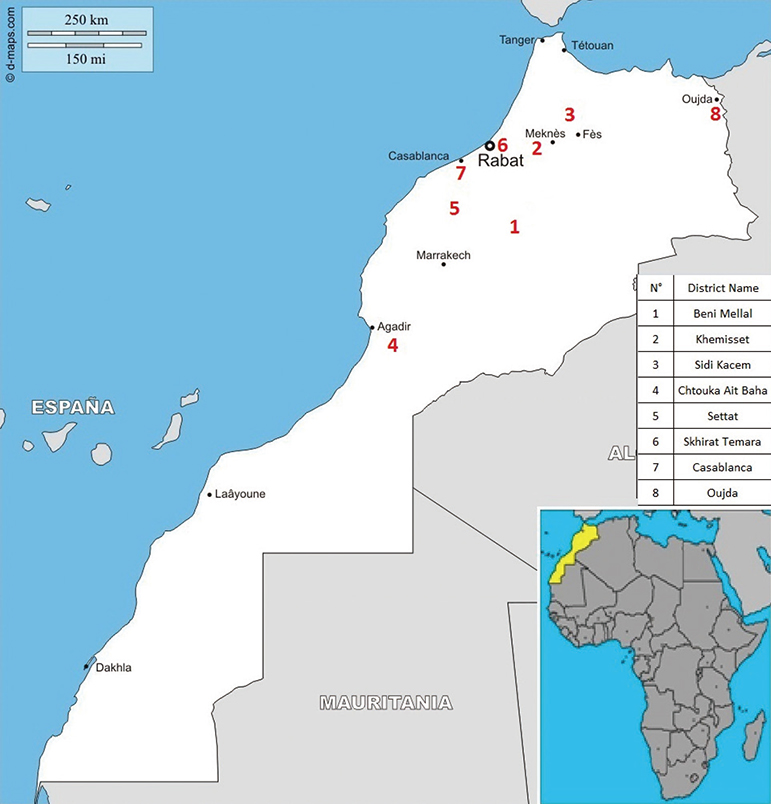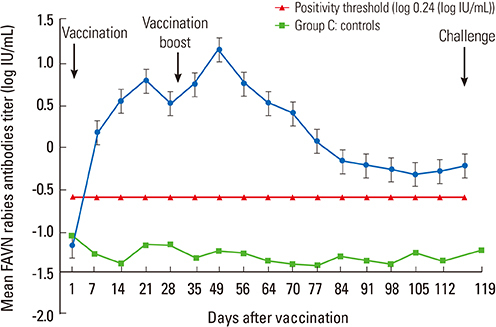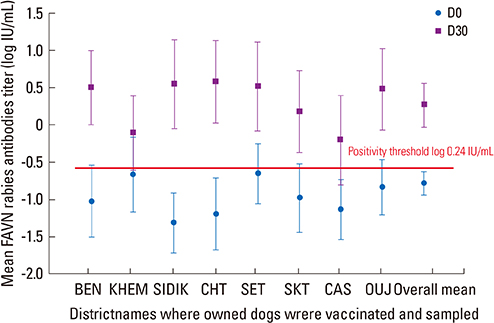Clin Exp Vaccine Res.
2016 Jan;5(1):60-69. 10.7774/cevr.2016.5.1.60.
Immunogenicity and efficacy of Rabivac vaccine for animal rabies control in Morocco
- Affiliations
-
- 1Office National de Securite Sanitaire des Produits Alimentaires, DPIV Rue Ikhlass CYM (BP4509 Akkari), Rabat, Morocco. darkaouisami@gmail.com
- 2Department of Pathology and Veterinary Public Health, Agronomic and Veterinary Institute Hassan II, IAV Hassan II (BP Rabat Instituts), Rabat, Morocco.
- 3Nancy OIE/WHO/EU Laboratory for Rabies and Wildlife, French Agency for Food, Environmental and Occupational Health and Safety, Technopole Agricole et Veterinaire de Pixerecourt, Malzeville, France.
- KMID: 2152698
- DOI: http://doi.org/10.7774/cevr.2016.5.1.60
Abstract
- PURPOSE
To fight animal rabies, Moroccan veterinary authorities organize annual dog mass vaccination campaigns using Rabivac vaccine, an inactivated adjuvanted cell culture veterinary rabies vaccine. Two experiments were undertaken to assess the efficacy and immunogenicity of Rabivac.
MATERIALS AND METHODS
The first experiment involved 13 caged dogs (8 vaccinated and 5 negative controls). Dogs were bled at day 0 (D0) and at days D7, D14, D21, D28, D35, D49, D56, D64, D70, D77, D84, D91, D98, D105, D112, and D119 post-vaccination. At D121, a virulent challenge was performed. After 70 days monitoring period, seven out of eight vaccinated dogs survived the challenge (one dog succumbed to a mesenteric torsion accident) and four out of five controls succumbed. All vaccinated dogs seroconverted and the control dogs remained negative. The second experiment consisted in a field study involving 919 owned dogs randomly selected in eight Moroccan districts located in different parts of the country. The dogs were identified and vaccinated by the parenteral route and bled on the vaccination day (D0) and on D30.
RESULTS
Ninety-two percent of dogs developed a positive rabies virus neutralizing antibody response to vaccination and 24% were positive at D0, suggesting that dogs were previously vaccinated. The increase in rabies antibody titers was highly significant in all districts. No significant difference seemed occurring between the geographical status (rural, semiurban, or urban) of the districts on the results obtained.
CONCLUSION
Rabivac is efficacious both in experimental and field conditions. This supports its use in dog mass vaccination campaigns.
MeSH Terms
Figure
Reference
-
1. Knobel DL, Cleaveland S, Coleman PG, et al. Re-evaluating the burden of rabies in Africa and Asia. Bull World Health Organ. 2005; 83:360–368.2. Matter H, Blancou J, Benelmouffok A, Hammami S, Fassi-Fehri N. Rabies in North Africa and Malta. In : King AA, Fooks AR, Aubert M, Wandeler AI, editors. Historical perspective of rabies in Europe and the Mediterranean Basin. Paris: World Organisation for Animal Health;2004. p. 185–199.3. Fassi-Fihri O. Historique et situation épidémiologique de la rage au Maroc. Renforcement de la surveillance et des systèmes d'alerte pour la fièvre catarrhale ovine, la fièvre du Nil occidental et la rage au Maroc, en Algérie et en Tunisie. Projet FAO GCP/RAB/002/FRA. Rome: Food and Agriculture Organization of the United Nations;2008.4. Dodet B. Africa Rabies Bureau (AfroREB). The fight against rabies in Africa: from recognition to action. Vaccine. 2009; 27:5027–5032.
Article5. El-Harrak M. Epidemiological factors and control of rabies in North Africa. In : Compendium of the OIE Global Conference on Rabies Control; 2011 Sep 7-9; Incheon, Korea. Paris: World Organisation for Animal Health;2012. p. 45–49.6. World Health Organization. Morocco [Internet]. Geneva: World Health Organization;2014. cited 2015 Oct 1. Available from: http://www.who.int/rabies/epidemiology/Rabies_CP_Morocco_09_2014.pdf?ua=1.7. Barkia A. Evaluation du système de surveillance de la rage humaine au Maroc [Internet]. Senegal: Journee Mondiale de la Rage;2013. cited 2015 Oct 1. Available from: http://searg.info/fichiers/afroreb/2013/presentations/afroreb2013_08.pdf.8. Darkaoui S, Boue F, Demerson JM, Fassi Fihri O, Yahia KI, Cliquet F. First trials of oral vaccination with rabies SAG2 dog baits in Morocco. Clin Exp Vaccine Res. 2014; 3:220–226.
Article9. Meslin FX. Strategy, approaches, guidance and resources for human and dog rabies control. In : FAO/GARC Workshop; 2012 Nov 6-8; Rome, Italy. Rome: Food and Agriculture Organization of the United Nations;2013. p. 3–5.10. World Health Organization. Oral vaccination of dogs against rabies: guidance for research on oral rabies vaccines and field application of oral vaccination of dogs against rabies. Geneva: World Health Organization;2007.11. World Health Organization. WHO expert consultation on rabies: second report. Geneva: World Health Organization;2013.12. Aubert MF. Practical significance of rabies antibodies in cats and dogs. Rev Sci Tech. 1992; 11:735–760.
Article13. Barth R, Gruschkau H, Jaeger O. Chick-embryo-cell inactivated rabies vaccine for veterinary use: laboratory and field experience. In : Kuwert E, Mérieux C, Koprowski H, Bogel K, editors. Rabies in the tropics. Berlin: Springer Verlag;1985. p. 241–248.14. Cliquet F, Aubert M, Sagne L. Development of a fluorescent antibody virus neutralisation test (FAVN test) for the quantitation of rabies-neutralising antibody. J Immunol Methods. 1998; 212:79–87.
Article15. World Organisation for Animal Health. Rabies [Internet]. Paris: World Organisation for Animal Health;2013. cited 2015 Oct 1. Available from: http://www.oie.int/fileadmin/Home/fr/Health_standards/tahm/2.01.13_RABIES.pdf.16. European Depatment for the Quality of Medicines, Council of Europe. Rabies vaccine (inactivated) for veterinary use. Mongraph 0451. European Pharmacopoeia. 7th ed. Strasbourg: Council of Europe;2013. p. 1008–1011.17. Perrin P, Jacob Y, Aguilar-Setien A, et al. Immunization of dogs with a DNA vaccine induces protection against rabies virus. Vaccine. 1999; 18:479–486.
Article18. Meslin FX, Kaplan MM, Koprowski H. Laboratory techniques in rabies. 4th ed. Geneva: World Health Organization;1996.19. Cliquet F, Sagne L, Schereffer JL, Aubert MF. ELISA test for rabies antibody titration in orally vaccinated foxes sampled in the fields. Vaccine. 2000; 18:3272–3279.
Article20. Millan J, Chirife AD, Kalema-Zikusoka G, et al. Serosurvey of dogs for human, livestock, and wildlife pathogens, Uganda. Emerg Infect Dis. 2013; 19:680–682.
Article21. Wasniewski M, Guiot AL, Schereffer JL, Tribout L, Mahar K, Cliquet F. Evaluation of an ELISA to detect rabies antibodies in orally vaccinated foxes and raccoon dogs sampled in the field. J Virol Methods. 2013; 187:264–270.
Article22. Hammami S, Schumacher C, Cliquet F, Tlatli A, Aubert A, Aubert M. Vaccination of Tunisian dogs with the lyophilised SAG2 oral rabies vaccine incorporated into the DBL2 dog bait. Vet Res. 1999; 30:607–613.23. Coleman PG, Dye C. Immunization coverage required to prevent outbreaks of dog rabies. Vaccine. 1996; 14:185–186.
Article24. Kallel H, Diouani MF, Loukil H, et al. Immunogenicity and efficacy of an in-house developed cell-culture derived veterinarian rabies vaccine. Vaccine. 2006; 24:4856–4862.
Article25. Mansfield KL, Burr PD, Snodgrass DR, Sayers R, Fooks AR. Factors affecting the serological response of dogs and cats to rabies vaccination. Vet Rec. 2004; 154:423–426.
Article26. Minke JM, Bouvet J, Cliquet F, et al. Comparison of antibody responses after vaccination with two inactivated rabies vaccines. Vet Microbiol. 2009; 133:283–286.
Article27. Cliquet F, Muller T, Mutinelli F, et al. Standardisation and establishment of a rabies ELISA test in European laboratories for assessing the efficacy of oral fox vaccination campaigns. Vaccine. 2003; 21:2986–2993.
Article28. Cliquet F, Verdier Y, Sagne L, et al. Neutralising antibody titration in 25,000 sera of dogs and cats vaccinated against rabies in France, in the framework of the new regulations that offer an alternative to quarantine. Rev Sci Tech. 2003; 22:857–866.
Article29. Tepsumethanon W, Polsuwan C, Lumlertdaecha B, et al. Immune response to rabies vaccine in Thai dogs: a preliminary report. Vaccine. 1991; 9:627–630.
Article30. Perrin P, Jacob Y, Desmezieres E, Tordo N. DNA-based immunisation against rabies and rabies-related viruses: towards multivalent vaccines. Dev Biol (Basel). 2000; 104:151–157.31. Cliquet F, Barrat J, Guiot AL, et al. Efficacy and bait acceptance of vaccinia vectored rabies glycoprotein vaccine in captive foxes (Vulpes vulpes), raccoon dogs (Nyctereutes procyonoides) and dogs (Canis familiaris). Vaccine. 2008; 26:4627–4638.
Article32. Davlin SL, Vonville HM. Canine rabies vaccination and domestic dog population characteristics in the developing world: a systematic review. Vaccine. 2012; 30:3492–3502.
Article33. Lembo T, Hampson K, Kaare MT, et al. The feasibility of canine rabies elimination in Africa: dispelling doubts with data. PLoS Negl Trop Dis. 2010; 4:e626.
Article
- Full Text Links
- Actions
-
Cited
- CITED
-
- Close
- Share
- Similar articles
-
- Strategies to maintain Korea's animal rabies non-occurrence status
- A genetically modified rabies vaccine (ERAGS) induces protective immunity in dogs and cattle
- The present and future of rabies vaccine in animals
- Antibody Response in Korean Raccoon Dogs Inoculated with Inactivated Rabies Vaccines
- Immunogenicity of an inactivated rabies vaccine for animals derived from the recombinant ERAGS strain




